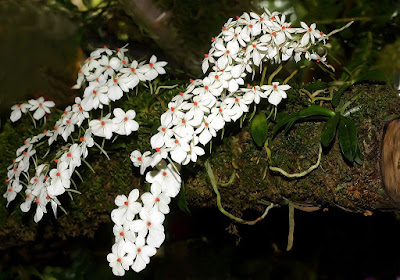Aerangis luteoalba var. rhodosticta is native to Africa. The plants of this species grow in the equatorial area of Africa from Cameroon to Congo in the west through the central and western forests of Uganda to Somalia, Ethiopia and Kenya in the east...
Aerangis luteoalba var. rhodosticta also called as The Beige Aerangis with Red Spots, Aerangis albidorubra, Aerangis rhodistica, Angorchis rhodosticta, Angraecum albidorubrum, Angraecum luteo-album, Angraecum mirabilis, Angraecum rhodisticum, Rhaphidorhynchus luteoalbus, is a subspecies of the genus Aerangis. This subspecies was described by Joyce Stewart in 1979.
IDENTIFY AERANGIS LUTEOALBA VAR RHODOSTICTA
Aerangis luteoalba var. rhodosticta is native to Africa. The plants of this species grow in the equatorial area of Africa from Cameroon to Congo in the west through the central and western forests of Uganda to Somalia, Ethiopia and Kenya in the east. In Kenya, these plants can usually be found at an altitude of 910-1520 m on the southern and south-eastern slopes of Mount Kenya and on the southern slopes of Mount Elgon. They grows in wet and hot habitats, almost always in forests on rivers. These plants usually grow in areas sheltered from the wind, usually near waterfalls. They are usually placed on twigs and branches of shrubs, but sometimes they can be found on tree trunks.
It is a miniature to just small sized, epiphytic species with flattened roots, a very short stem carrying several spreading, more or less distichous, linear, curved, fleshy, unequally bilobed apically, usually less than 15 cm long leaf that are all set in the same plane leaves and can be mounted such as this one, on cork or tree fern.
The Beige Aerangis with Red Spots can bloom in the winter or spring and they have fragrant flowers in two flat rows, on a axillary, to 40 cm long, fractiflex, arching or pendulous inflorescence with small floral bracts. The flowers are 2.5-5.0 cm long. After opening, they are very flat, evenly arranged on the inflorescence, which gives the plant a very neat and orderly appearance. The color varies from pure white to white ivory, cream or pale yellow. The spine is light scarlet or cinnabar, which gives a very strong contrast.
AERANGIS LUTEOALBA VAR RHODOSTICTA CARE AND CULTURE
Cultural information should only be used as a guide, and should be to be adapted to suit you. Your physical location; where you grow your plants, how much time you have to devote to their care, and many other factors, will need to be taken into account. Only then can you decide on the cultural methods that best suit you and your plants.
Light:
Aerangis luteoalba var. rhodosticta needs a light level of 12000-20000 lux. This species grow well on window sills or under artificial lighting. You can use fluorescent lamps and placing the plants 15-23 cm below the light source.
Temperature:
It is a thermophilic plant The average summer temperature in the summer is 24-27 ° C, and at night 14 ° C, with daily temperature fluctuations of 10-13 ° C. In winter, the average day temperature is 21-23 ° C, at night 13-14 ° C, with a daily amplitude of 8-9 ° C.
Humidity:
The Beige Aerangis with Red Spots needs the average humidity of 70-75% for most of the year with a drop to almost 65% for a short period in early spring. In the late summer, the humidity increases for a short period before falling to a level of 55-60% for 3 months.
Substrate, growing media and repotting:
Aerangis luteoalba var. rhodosticta grow best when fixed on cork pieces with a certain amount of sphagnum moss placed under the plant. The plants did not grow well on tree root pods. The plants mounted in this way require high humidity of the air. In addition, attached plants must be misted at least once a day for most of the year, and the hottest days of summer may require several additional fogs. If it is necessary to use pots, you can use a very loose substrate to allow air to enter the roots. You can use medium or large size pieces of fir bark. However, it seems that young seedlings grow better and less often lose their roots if a loose mixture of pumice or coconut fibers is used, and not a base based on fir bark. Use as small as possible clay pots.
Repotting should be carried out when new roots start growing, which allows the plant to settle in the new container as quickly as possible.
Watering:
The Beige Aerangis with Red Spots should be kept moist in autumn and spring. In winter and in summer, they should allow a slight drying between waterings, but the substrate should never completely dry up and the plants should not be dried out for a long period of time. In the case of plants mounted on rootstocks, it is recommended to fog 5 times a week outside the winter period and rainy days. During hot weather, the plants should also be well moistened daily or completely immersed in water 3 times a week.
Fertilizer:
During the period of strong growth, the plant should be fertilized every week 1/4-1/2 of the recommended dose of fertilizer for orchids. You can use fertilizer with low nitrogen content and high phosphorus content in autumn. If pots are used for cultivation, every few weeks the soil should be rinsed to avoid the formation of mineral deposits, especially when high doses of fertilizers are used. Rinsing throughout the whole year is important especially where the water is highly mineralized.
Rest period:
In 4 months of winter and two months of summer, early morning fogging and thorough watering about every two weeks is recommended for Aerangis luteoalba var. rhodosticta. Special attention should be paid to any signs of weakening of the plants during periods of reduced watering, especially in summer. If such signs appear, the amount of water should be increased.















COMMENTS